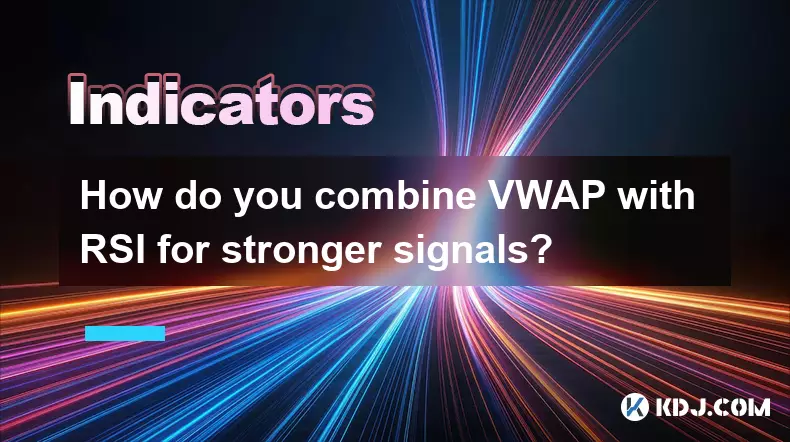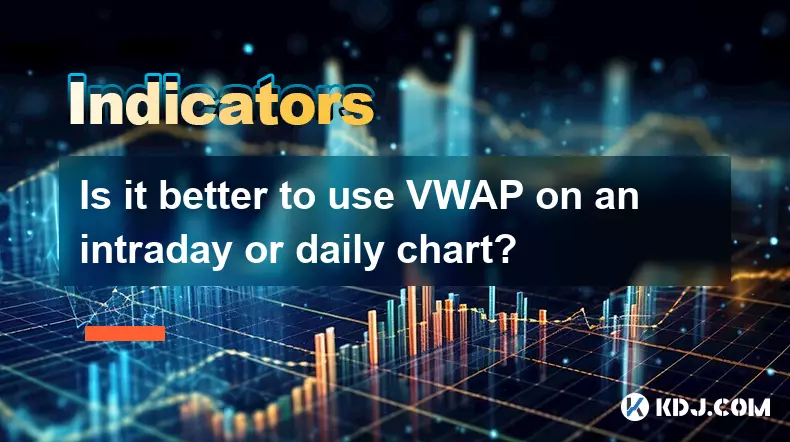-
 bitcoin
bitcoin $110918.433029 USD
-1.69% -
 ethereum
ethereum $3996.872473 USD
-2.43% -
 tether
tether $1.000594 USD
0.00% -
 bnb
bnb $1178.871834 USD
-2.38% -
 xrp
xrp $2.413973 USD
-3.47% -
 solana
solana $194.341461 USD
-4.24% -
 usd-coin
usd-coin $0.999963 USD
-0.03% -
 tron
tron $0.320092 USD
0.92% -
 dogecoin
dogecoin $0.196919 USD
-3.42% -
 cardano
cardano $0.669585 USD
-3.63% -
 hyperliquid
hyperliquid $37.485952 USD
-3.58% -
 ethena-usde
ethena-usde $1.000026 USD
-0.02% -
 chainlink
chainlink $18.018220 USD
-5.13% -
 bitcoin-cash
bitcoin-cash $523.879267 USD
-2.41% -
 stellar
stellar $0.324655 USD
-3.67%
How do you combine VWAP with RSI for stronger signals?
Combining VWAP and RSI enhances crypto trading accuracy by aligning volume-weighted price trends with momentum signals, filtering out noise and improving entry/exit timing.
Oct 10, 2025 at 12:36 pm

Understanding the Synergy Between VWAP and RSI
1. The Volume Weighted Average Price (VWAP) serves as a benchmark for institutional traders, reflecting the average price a cryptocurrency has traded at throughout the day, based on both volume and price. It is particularly effective in identifying fair value during intraday trading sessions within the crypto markets, where volatility can skew traditional moving averages.
2. The Relative Strength Index (RSI), on the other hand, measures the speed and change of price movements, typically on a 0–100 scale. When applied to digital assets, RSI helps identify overbought or oversold conditions, offering insight into potential reversal points amid rapid price swings common in cryptocurrencies.
3. Combining VWAP with RSI allows traders to filter out false signals by aligning momentum indicators with volume-based price trends. Instead of relying solely on price crossing above or below VWAP, integrating RSI adds confirmation through momentum analysis, increasing the reliability of trade entries and exits.
4. For instance, when price trades above VWAP and RSI moves from below 30 to above 50, it suggests strong bullish momentum supported by volume. Conversely, if price remains below VWAP while RSI drops from above 70 to below 50, bearish conviction may be increasing with volume backing the downtrend.
5. This dual-filter approach reduces noise in highly speculative environments like altcoin trading, where pump-and-dump schemes or whale manipulation can distort price action. By requiring alignment between volume-weighted pricing and momentum strength, traders improve their odds of participating in sustainable moves.
Key Conditions for Signal Confirmation
1. A long entry is considered high probability when price crosses above VWAP after a pullback and RSI emerges from oversold territory (below 30) and begins trending upward. This indicates that buying pressure is returning with volume support, often signaling accumulation by larger players.
2. A short opportunity arises when price fails to sustain moves above VWAP and RSI shows rejection from overbought levels (above 70). If RSI starts declining while price stays below VWAP, it reflects weakening momentum and growing selling pressure, especially if accompanied by rising volume.
3. Divergences between price and RSI near VWAP boundaries offer powerful clues. For example, if price makes a higher low near VWAP but RSI forms a lower low, hidden bearish divergence may precede a breakdown despite apparent strength in price structure.
4. In ranging markets, VWAP flattens and acts as dynamic resistance or support. When RSI oscillates between 40 and 60 around a flat VWAP line, it suggests indecision. Breakouts gain credibility only when RSI breaks this range concurrently with a decisive move through VWAP with expanding volume.
5. Timeframe alignment enhances accuracy. Using VWAP on a 15-minute chart along with RSI(14) provides timely signals, while confirming direction with a higher timeframe VWAP slope ensures trades are taken in the direction of dominant intraday sentiment.
Practical Applications in Crypto Trading
1. During Bitcoin’s sharp retracements following all-time highs, many altcoins experience panic selling. Traders monitor whether price finds support at VWAP with RSI bouncing from 30. If both conditions align, it often marks a capitulation point before a relief rally fueled by mean reversion algorithms.
2. On exchanges like Binance or Bybit, perpetual futures contracts exhibit pronounced VWAP sensitivity due to high-frequency trading activity. Day traders use anchored VWAP from key session lows, pairing it with RSI to detect early trend resumptions after consolidation phases.
3. In bull runs, leading altcoins frequently retest VWAP after breakout spikes. If RSI holds above 50 during these tests without dipping into oversold zones, it confirms underlying demand and supports continuation patterns such as flags or ascending triangles.
4. Automated trading bots increasingly incorporate VWAP+RSI logic to execute limit orders. For example, a bot might place buy limits slightly below VWAP when RSI falls to 35–40, anticipating a bounce with minimal slippage compared to market orders.
5. Scalpers focus on 1-minute and 5-minute charts where VWAP deviations are frequent. They enter longs only when micro-candles close above VWAP and RSI crosses above 50 from neutral ground, avoiding traps caused by spoofed orders or liquidity grabs.
Frequently Asked Questions
What timeframes work best for combining VWAP and RSI? The 5-minute to 30-minute charts are most effective for active crypto traders. These intervals balance signal frequency with meaningful volume data, allowing VWAP to reflect genuine market activity while RSI remains responsive enough to capture momentum shifts.
Can VWAP and RSI be used in sideways markets? Yes, but with caution. In choppy conditions, VWAP tends to flatten and RSI oscillates within a narrow band. Entries should wait for a compression breakout confirmed by both a steep VWAP angle and RSI breaking beyond 60 or below 40 to avoid whipsaws.
Is RSI period adjustment necessary when using it with VWAP? Adjusting RSI from the default 14 to 10 can increase sensitivity, which complements VWAP’s lagging nature. A shorter RSI period detects momentum changes earlier, helping traders anticipate VWAP rejections or breakthroughs before they fully materialize.
How does anchoring VWAP affect RSI integration? Anchored VWAP, set to significant swing points, creates more meaningful reference levels. When combined with RSI, it helps assess momentum relative to structural highs or lows. For example, price reclaiming an anchored VWAP from a major bottom with RSI rising past 50 signals strong recovery potential.
Disclaimer:info@kdj.com
The information provided is not trading advice. kdj.com does not assume any responsibility for any investments made based on the information provided in this article. Cryptocurrencies are highly volatile and it is highly recommended that you invest with caution after thorough research!
If you believe that the content used on this website infringes your copyright, please contact us immediately (info@kdj.com) and we will delete it promptly.
- Uncirculated Queen Elizabeth £2 Coins: A Collector's Guide
- 2025-10-16 12:25:12
- Jimmie Bones' Battle with ALS: Kid Rock's Heartfelt Support
- 2025-10-16 12:25:12
- Crypto Market Rollercoaster: Fear & Greed, DeFi Dips, and the Next Big Thing
- 2025-10-16 12:30:01
- Ethereum Foundation, Morpho Protocol, and Treasury Management: A New Era of DeFi Engagement
- 2025-10-16 12:30:01
- Larry Fink and BlackRock: Tokenizing All the Assets, Baby!
- 2025-10-16 11:05:12
- Meme Coin Mania: MoonBull, FLOKI, and SHIB – What's the Buzz?
- 2025-10-16 09:10:00
Related knowledge

What's the main difference between VWAP and TWAP?
Oct 12,2025 at 11:54am
Understanding VWAP and Its Role in Crypto Trading1. Volume Weighted Average Price (VWAP) is a trading benchmark that calculates the average price of a...

How do you identify exhaustion moves using VWAP and its bands?
Oct 12,2025 at 08:00am
Understanding the Role of Decentralized Exchanges in Crypto Trading1. Decentralized exchanges (DEXs) operate without a central authority, allowing use...

Is it better to use VWAP on an intraday or daily chart?
Oct 15,2025 at 02:01am
Intraday Trading and the Role of VWAP1. Intraday traders frequently rely on VWAP (Volume Weighted Average Price) as a dynamic benchmark for assessing ...

How do you use VWAP to scale in and out of positions?
Oct 14,2025 at 02:19am
Understanding VWAP as a Dynamic Benchmark1. The Volume Weighted Average Price (VWAP) is not just an indicator—it functions as a dynamic benchmark that...

What are the main advantages of using VWAP over EMA?
Oct 11,2025 at 02:18am
Main Advantages of Using VWAP Over EMA1. Volume-Weighted Average Price (VWAP) incorporates trading volume into its calculation, offering a more accura...

How do you use VWAP on different chart types like Heikin Ashi?
Oct 11,2025 at 05:01pm
Understanding VWAP in the Context of Heikin Ashi Charts1. The Volume Weighted Average Price (VWAP) is a powerful analytical tool commonly used by trad...

What's the main difference between VWAP and TWAP?
Oct 12,2025 at 11:54am
Understanding VWAP and Its Role in Crypto Trading1. Volume Weighted Average Price (VWAP) is a trading benchmark that calculates the average price of a...

How do you identify exhaustion moves using VWAP and its bands?
Oct 12,2025 at 08:00am
Understanding the Role of Decentralized Exchanges in Crypto Trading1. Decentralized exchanges (DEXs) operate without a central authority, allowing use...

Is it better to use VWAP on an intraday or daily chart?
Oct 15,2025 at 02:01am
Intraday Trading and the Role of VWAP1. Intraday traders frequently rely on VWAP (Volume Weighted Average Price) as a dynamic benchmark for assessing ...

How do you use VWAP to scale in and out of positions?
Oct 14,2025 at 02:19am
Understanding VWAP as a Dynamic Benchmark1. The Volume Weighted Average Price (VWAP) is not just an indicator—it functions as a dynamic benchmark that...

What are the main advantages of using VWAP over EMA?
Oct 11,2025 at 02:18am
Main Advantages of Using VWAP Over EMA1. Volume-Weighted Average Price (VWAP) incorporates trading volume into its calculation, offering a more accura...

How do you use VWAP on different chart types like Heikin Ashi?
Oct 11,2025 at 05:01pm
Understanding VWAP in the Context of Heikin Ashi Charts1. The Volume Weighted Average Price (VWAP) is a powerful analytical tool commonly used by trad...
See all articles


























![Web3 Crypto Market Morning Report: The market is in decline, altcoins have fallen by more than 5%, Binance compensation has been received, and Memes on the Bnb chain have collectively plummeted [Vic TALK Issue 1444] Web3 Crypto Market Morning Report: The market is in decline, altcoins have fallen by more than 5%, Binance compensation has been received, and Memes on the Bnb chain have collectively plummeted [Vic TALK Issue 1444]](/uploads/2025/10/16/cryptocurrencies-news/videos/web-crypto-market-morning-report-market-decline-altcoins-fallen-binance-compensation-received-memes-bnb-chain-collectively-plummeted-vic-talk-issue/68f043c9c8b44_image_500_375.webp)















































